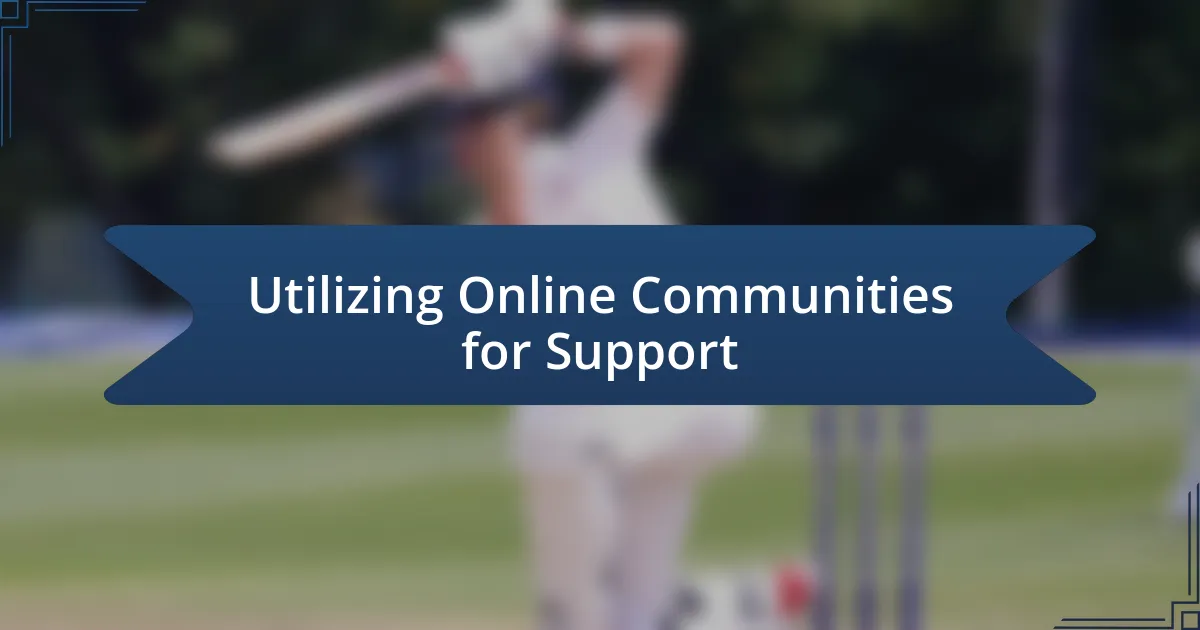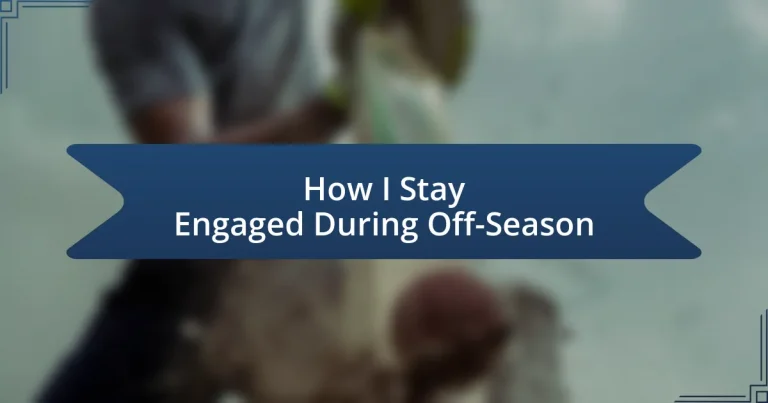Key takeaways:
- Utilizing the off-season for personal growth, skill development, and setting clear engagement goals can enhance athletic motivation and focus.
- Creating a structured yet flexible routine helps maintain engagement and accountability during the off-season, allowing for both training and enjoyment.
- Exploring new hobbies and engaging in online communities provide valuable support and inspiration, fostering resilience and broadening personal development.
- Planning for a smooth transition into the on-season through gradual intensity increase and well-defined goals is essential to prevent injury and ensure readiness.

Understanding the Off-Season Impact
The off-season can be a challenging time for athletes and enthusiasts alike, as the absence of regular competition can lead to feelings of restlessness and disengagement. I remember a few years back, during one particularly long off-season, I felt a sense of urgency to find alternative ways to hone my skills, rather than just waiting for the next season to begin. This period of introspection not only helped me maintain my focus but also made me reevaluate my long-term goals.
Without structured training, it’s easy to slip into a routine that lacks the motivation we typically feel during the season. Have you ever found yourself drifting, wondering how to keep that fire alive when the games are on pause? I certainly have. Exploring new activities related to my sport helped reignite that passion—whether it was joining a local league or even volunteering at youth clinics. These experiences provided not only a break from the monotony but also a deeper connection to my community.
Understanding the psychological impact of the off-season can significantly change how we approach this downtime. I learned to see it as a valuable opportunity for growth rather than just a void to be filled. Reflecting on my past, I’ve discovered that embracing this time can foster resilience and creativity, allowing me to return to my sport with revitalized energy and purpose. How are you using your off-season to nurture your passion?

Setting Clear Engagement Goals
Setting clear engagement goals can transform the off-season into a rewarding phase of personal and athletic development. It reminds me of a time when I decided to focus on specific skills I wanted to improve rather than aimlessly training. By setting distinct, achievable goals, I transformed my practice sessions from routine checkboxes into purposeful endeavors, which kept me motivated and focused.
To effectively set your engagement goals, consider the following:
– Define your objective clearly. What specific skills do you want to develop?
– Break down your goals into smaller, manageable tasks. This makes them less daunting.
– Set a timeline for each goal. Having deadlines adds a sense of urgency and commitment.
– Reflect on your progress regularly. Adjust your strategies based on what works and what doesn’t.
– Celebrate your achievements, no matter how small. They all contribute to your overall progress.
With each step, I felt more connected to my mission and less burdened by the absence of competition. Define your path forward and use this time to truly grow.

Creating a Structured Routine
Creating a structured routine is essential for maintaining engagement during the off-season. Personally, I’ve found that crafting a daily schedule helps me stay focused. For example, I allocate specific times for training, skill development, and even rest. Having this framework allows me to treat each day like a mini-competition, where I’m accountable to myself.
Building on that idea, I can’t stress enough the importance of flexibility within that routine. There were days when my motivation dipped, and rather than forcing myself through a tough workout, I swapped it out for a lighter, more enjoyable activity—like a leisurely run or some yoga. This helped me maintain enthusiasm while still sticking to my commitment to progress. Recognizing when to adjust is key to sustaining momentum.
Lastly, incorporating a variety of activities into my routine has been a game changer. I remember a time when I committed to cross-training. Not only did this keep things fresh, but it also allowed me to discover new interests, like cycling, that complemented my primary sport. Ultimately, a structured yet adaptable routine keeps the off-season engaging and productive.
| Aspect | Structured Routine |
|---|---|
| Time Management | Allocates specific times for training, recovery, and skill work. |
| Flexibility | Adjust workouts based on motivation levels to maintain engagement. |
| Diversity | Includes various activities to keep things interesting and support overall development. |

Exploring New Skills and Hobbies
Exploring new skills and hobbies during the off-season has truly enriched my life. I vividly recall the excitement I felt when I picked up painting. The moment I dipped my brush into the vibrant colors, I realized it wasn’t just about creating art; it was a meditative experience. It offered me a chance to express emotions that sometimes felt too overwhelming to articulate. Have you ever discovered a hobby that transformed how you felt about your daily routine?
Taking on new hobbies doesn’t just fill the time; it has a direct impact on my mindset. Recently, I started learning guitar. Initially, it was frustrating, but as I progressed, my sense of accomplishment grew. I found that the patience I developed while practicing guitar actually made my training feel more manageable. Isn’t it fascinating how one skill can enhance another area of our lives?
Moreover, I’ve noticed that trying something totally outside my usual interests opens up unexpected avenues for growth. For instance, dabbling in photography taught me to pay closer attention to details in my environment, which translated beautifully into my main sport. It made me wonder—how often do we limit ourselves by sticking to what we know? By making the choice to explore, I continue to develop not just as an athlete, but as a well-rounded individual.

Utilizing Online Communities for Support
When I first ventured into online communities, I felt an instant sense of belonging. Connecting with others who shared my passions, especially during the off-season, provided a much-needed support network. Have you ever experienced that rush of having your struggles validated by people who understand exactly what you’re going through?
In forums and social media groups, I’ve found that sharing my challenges often leads to invaluable advice and encouragement. I vividly remember posting about my off-season training plateaus; the feedback I received not only reignited my motivation but also opened my eyes to new training techniques I hadn’t considered. How often do we think we’re on our own, only to discover that others are facing the same hurdles?
What surprises me the most is the power of collective energy within these online spaces. There was one day I felt particularly unmotivated, and after I engaged in a group discussion, I walked away inspired by the stories of resilience from fellow athletes. This interaction reminded me that even in the digital realm, a supportive community can breathe life back into our passions. Have you tapped into that potential yet?

Incorporating Physical Fitness Activities
Incorporating physical fitness activities during the off-season has become a cornerstone of my routine. Recently, I decided to try yoga, which not only improved my flexibility but also helped me find a surprising sense of calm amid the hectic nature of life. Have you ever discovered a workout that served a dual purpose, like fitness and stress relief?
I remember one particularly rainy day when I felt the urge to skip my usual workout. Instead, I pulled out my jump rope and set a timer for 15 minutes. It was exhilarating to feel my heart rate elevate and my mood lift, reminding me how quickly physical activity can turn around a gloomy day. How often do we underestimate the simple joys of a quick, spontaneous workout?
Engaging in physical activities doesn’t always require a gym or a structured program. Last summer, I joined a local hiking group, and it transformed my perspective on exercise. The fresh air, beautiful scenery, and camaraderie made it clear that fitness can be an adventure rather than a chore. Have you ever considered that stepping outside might be the perfect way to stay active and connected?

Planning for On-Season Transition
As I approach the on-season, planning becomes essential. I find that creating a detailed schedule helps me map out my workouts and goals. This preparation not only reduces the stress of last-minute decisions but also makes me feel more engaged as I see my progress laid out in front of me.
Last spring, I decided to transition from off-season activities to my on-season routine. I developed a checklist that included setting specific goals, such as increasing my endurance and refining my technique. By breaking it down into manageable steps, I felt excited and motivated rather than overwhelmed. It prompted me to ask, how can setting clear milestones make your own fitness journey more fulfilling?
I’ve learned that a gradual increase in intensity is crucial for a successful transition. I vividly recall the discomfort I faced when I jumped back into my training too quickly after a break. The soreness was a harsh reminder that pacing is vital. So, reflect on your last experience: did rushing back ever set you back? Taking the time to gradually adapt has since enabled me to build strength and confidence without risking injury.





